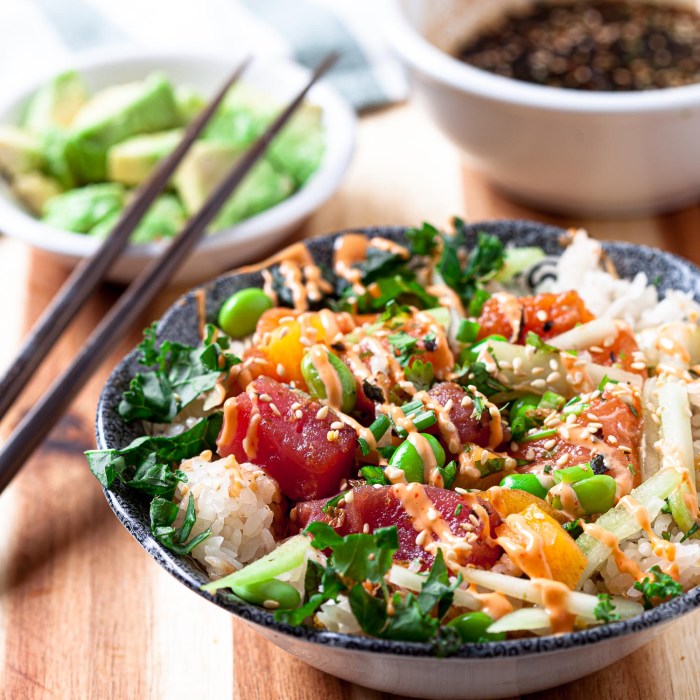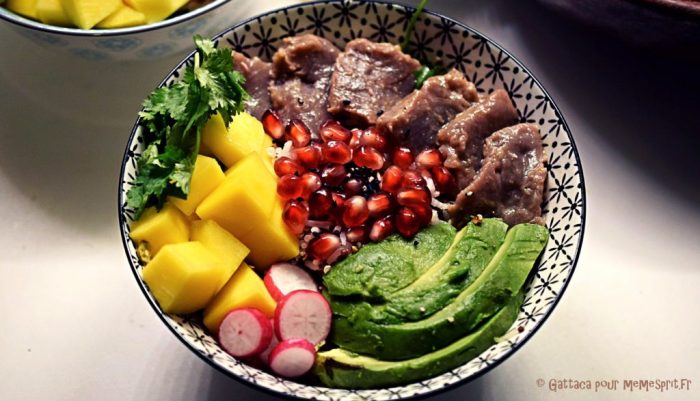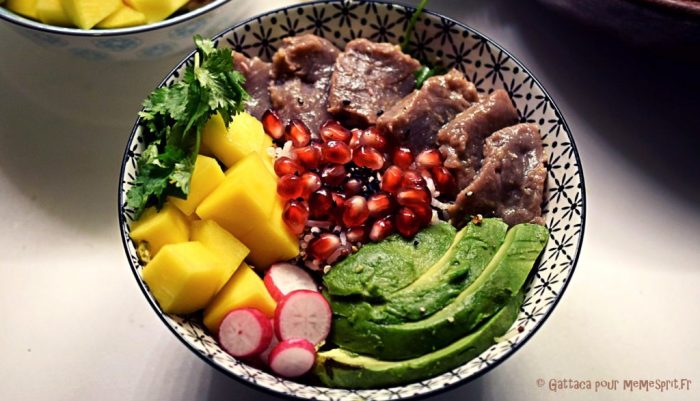DIY poke bowls have become a culinary sensation, offering a delightful fusion of flavors and textures. The beauty of a DIY poke bowl lies in its customizable nature, allowing you to tailor your creation to your specific taste preferences. Whether you’re a seasoned sushi enthusiast or a curious newcomer, this guide will empower you to craft your own personalized poke bowl masterpieces.
With an array of fresh ingredients, vibrant toppings, and flavorful sauces at your disposal, the possibilities are truly endless. From the choice of protein to the selection of toppings, each decision contributes to the unique character of your poke bowl. So, grab your bowls, gather your ingredients, and embark on a culinary adventure that will tantalize your taste buds.
Essential Ingredients for a DIY Poke Bowl
A poke bowl is a Hawaiian dish that consists of fresh raw fish, typically tuna or salmon, served over rice with a variety of other ingredients. While it may seem complex, the core ingredients are simple and can be easily customized to your taste. Let’s dive into the key elements of a poke bowl and how to make it your own.
Protein Options
The star of the show in a poke bowl is undoubtedly the protein. While tuna and salmon are classic choices, there’s a wide array of protein options to choose from, allowing you to experiment with different flavors and textures.
- Tuna: The most common protein used in poke bowls, tuna provides a lean and flavorful base. It can be served raw, marinated, or cooked, offering versatility in preparation.
- Salmon: Another popular choice, salmon adds a rich, fatty flavor to the bowl. It can be served raw, smoked, or cooked, each offering a distinct taste profile.
- Shrimp: Shrimp adds a delicate sweetness and tender texture to the poke bowl. It can be cooked, grilled, or even marinated for extra flavor.
- Octopus: For a more adventurous option, octopus offers a chewy texture and a slightly salty taste. It’s often marinated or cooked to enhance its flavor.
- Tofu: A great option for vegetarians, tofu provides a neutral canvas for various marinades and sauces. It absorbs flavors well and adds a satisfyingly firm texture.
Rice
The base of a poke bowl is typically rice, which provides a neutral foundation for the other flavors and ingredients. While white rice is commonly used, there are other options that can add different textures and flavors to your bowl.
- White Rice: The most popular choice, white rice is readily available and offers a neutral flavor that complements the other ingredients. It can be cooked in a rice cooker or on the stovetop.
- Brown Rice: A healthier alternative, brown rice has a slightly nutty flavor and a chewier texture than white rice. It’s a good source of fiber and nutrients.
- Sushi Rice: This sticky rice is ideal for poke bowls because it holds its shape well and can be easily mixed with the other ingredients. It’s often seasoned with rice vinegar, sugar, and salt.
- Quinoa: A gluten-free option, quinoa is a complete protein and offers a slightly earthy flavor and a slightly chewy texture. It can be cooked in a similar way to rice.
Creating a Flavorful Base

The sauce is the heart and soul of a poke bowl, adding a burst of flavor and binding all the ingredients together. It’s what elevates a simple bowl of rice and toppings into a culinary masterpiece. There are countless possibilities when it comes to poke bowl sauces, from classic shoyu to more creative blends.
Poke Bowl Sauce Recipes
There are several types of poke bowl sauces, each with its own unique flavor profile.
- Shoyu Sauce: A classic choice, shoyu sauce is a savory, umami-rich sauce made from soy sauce, sugar, and sesame oil. It’s a perfect base for a traditional poke bowl.
- Spicy Mayo: A creamy and spicy sauce made from mayonnaise, sriracha, and sometimes a touch of lime juice. This sauce adds a kick of heat and tang to the bowl.
- Mango Salsa: A refreshing and vibrant sauce made from diced mango, red onion, cilantro, and lime juice. This sauce adds a sweet and tangy element to the bowl.
- Sweet Chili Sauce: A sweet and savory sauce made from chili peppers, sugar, vinegar, and garlic. This sauce adds a touch of sweetness and heat to the bowl.
Marinades for Protein
Marinades are essential for adding flavor and tenderness to the protein in a poke bowl. They also help to keep the protein moist and prevent it from drying out.
- Soy Sauce Marinade: A simple marinade made from soy sauce, ginger, garlic, and sesame oil. This marinade adds a savory and umami flavor to the protein.
- Teriyaki Marinade: A sweet and savory marinade made from soy sauce, mirin, sugar, and ginger. This marinade adds a glaze to the protein.
- Lime Marinade: A refreshing marinade made from lime juice, olive oil, and herbs like cilantro or basil. This marinade adds a tangy and citrusy flavor to the protein.
Tips for Assembling the Perfect Poke Bowl: Diy Poke Bowl
Now that you’ve got all your ingredients ready, it’s time to build your poke bowl masterpiece. Assembling your poke bowl strategically ensures optimal flavor and texture, while preventing soggy rice. Here’s a guide to help you create a truly satisfying poke bowl experience.
Layering for Flavor and Texture
The key to a delicious poke bowl is to create layers of flavor and texture. This is achieved by carefully arranging your ingredients, ensuring each element complements the others.
- Start with a base of rice, quinoa, or salad greens. This provides a foundation for the other ingredients.
- Next, add your protein, such as tuna, salmon, tofu, or chicken. This adds a substantial element to your bowl.
- Layer on your favorite vegetables, such as avocado, cucumber, edamame, or seaweed. This provides freshness and crunch.
- Finish with your chosen toppings, such as sauces, sesame seeds, or pickled ginger. This adds a burst of flavor and visual appeal.
Ensuring Freshness and Preventing Soggy Rice
To ensure your poke bowl stays fresh and delicious, consider these tips:
- Avoid adding sauces directly to the rice. Instead, drizzle them over the other ingredients to prevent the rice from becoming soggy.
- Assemble your poke bowl just before serving. This will keep the ingredients fresh and prevent the rice from absorbing too much moisture.
- If you’re making your poke bowl in advance, store the rice separately and add it to the bowl right before serving. This will help keep the rice from becoming mushy.
Variations on the Classic Poke Bowl

The beauty of poke bowls lies in their adaptability. You can easily customize them to suit your taste preferences, dietary restrictions, and seasonal availability. Here are some exciting variations to explore:
Vegetarian Poke Bowls, Diy poke bowl
Vegetarian poke bowls are packed with fresh, flavorful ingredients, providing a satisfying and nutritious meal. They often feature a variety of plant-based proteins, such as tofu, tempeh, or edamame, along with colorful vegetables, fruits, and flavorful sauces.
- Tofu Poke Bowl: Marinate firm tofu in a mixture of soy sauce, sesame oil, and ginger for a savory base. Serve it with avocado, cucumber, mango, and a drizzle of sriracha mayo.
- Tempeh Poke Bowl: Crisp tempeh pieces can be tossed in a tangy sauce made with lime juice, soy sauce, and chili flakes. Pair it with shredded carrots, bell peppers, and a sprinkle of toasted sesame seeds.
- Edamame Poke Bowl: Boiled edamame beans can be tossed with a vibrant sauce made with rice vinegar, sesame oil, and a touch of honey. Add chopped seaweed, cucumber, and a sprinkle of toasted seaweed flakes.
Spicy Poke Bowls
If you enjoy a kick, consider adding a fiery touch to your poke bowl. Spicy poke bowls typically feature ingredients like sriracha, chili peppers, or wasabi, creating a delicious and satisfying heat.
- Sriracha Mayo Poke Bowl: Mix sriracha with mayonnaise to create a spicy and creamy sauce. Combine it with tuna, avocado, mango, and a sprinkle of sesame seeds.
- Chili Pepper Poke Bowl: Use a variety of chili peppers, such as jalapeno, serrano, or habanero, to create a fiery poke bowl. Combine them with salmon, red onion, pineapple, and a drizzle of soy sauce.
- Wasabi Poke Bowl: Wasabi paste can be added to the sauce or served as a garnish. Combine it with tuna, cucumber, avocado, and a sprinkle of sesame seeds.
Hawaiian-Style Poke Bowls
Hawaiian-style poke bowls are inspired by traditional Hawaiian cuisine. They typically feature raw fish marinated in a flavorful sauce, along with fresh ingredients and a touch of sweetness.
- Traditional Hawaiian Poke Bowl: Marinate raw ahi tuna in a mixture of soy sauce, sesame oil, and sea salt. Serve it with chopped onions, green onions, and a sprinkle of seaweed flakes.
- Pineapple Poke Bowl: Add chunks of fresh pineapple to your poke bowl for a sweet and tangy twist. Combine it with tuna, avocado, and a drizzle of soy sauce.
- Mango Poke Bowl: Mango adds a burst of tropical flavor to poke bowls. Combine it with tuna, cucumber, and a drizzle of soy sauce.
Creating a DIY poke bowl is an enjoyable and rewarding experience that allows you to express your culinary creativity. With a little planning and a dash of inspiration, you can assemble a symphony of flavors and textures that will leave you craving for more. Embrace the freedom to experiment with different ingredients, sauces, and toppings, and discover your own signature poke bowl creation.
DIY poke bowls are a fun and customizable way to enjoy a healthy meal. You can get creative with your ingredients, adding your favorite toppings and sauces. If you’re looking for a more dramatic costume idea, you might want to try a maleficent diy costume. Once you’ve finished with your costume, you can return to your DIY poke bowl creation and enjoy a delicious and satisfying meal.

